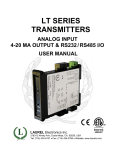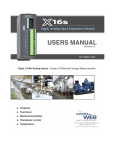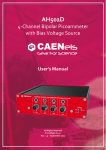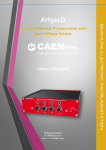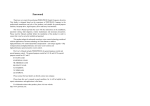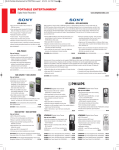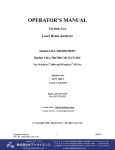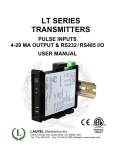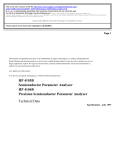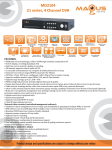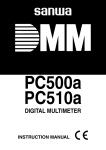Download AH401B Users Manual
Transcript
AH401B 4-Channel Picoammeter User’s Manual All Rights Reserved © Sincrotrone Trieste S.C.p.A Rev. 1.0 – October 2008 Sincrotrone Trieste S.C.p.A Strada Statale 14 - km 163,5 in AREA Science Park 34012 Basovizza, Trieste ITALY Tel. +39 040 37581 Fax. +39 040 9380902 www.elettra.trieste.it Table Of Contents 1. INTRODUCTION................................................................................................7 1.1 1.2 1.3 1.4 1.5 2. THE AH401B PICOAMMETER .........................................................................7 THE AH401B AT A GLANCE ...........................................................................8 FEATURES .......................................................................................................8 DATA FORMAT ..............................................................................................10 OFFSET CALIBRATION ...................................................................................11 SOFTWARE COMMANDS .............................................................................13 2.1 COMMAND SYNTAX ......................................................................................13 2.2 COMMAND LIST ............................................................................................15 2.2.1 “ACQ” Command................................................................................15 2.2.2 “BDR” Command................................................................................17 2.2.3 “BIN” Command .................................................................................18 2.2.4 “GET” and “?” Command..................................................................19 2.2.5 “HLF” Command ................................................................................20 2.2.6 “ITM” Command.................................................................................22 2.2.7 “RNG” Command................................................................................23 2.2.8 “TRG” Command ................................................................................24 2.2.9 “VER” Command ................................................................................25 2.3 COMMANDS TABLE SUMMARY .....................................................................26 3. COMMUNICATION MODULES ...................................................................27 3.1 MODULE HARDWARE INSTALLATION ...........................................................27 3.2 “ETHERPIGGY” MODULE ............................................................................28 3.2.1 “ETHERPiggy” IP Address Assign .....................................................28 3.2.2 “ETHERPiggy” Software Configuration ............................................31 4. I/O CONNECTORS...........................................................................................35 4.1 POWER CONNECTOR .....................................................................................35 4.2 I/O INTERFACE CONNECTOR .........................................................................35 4.2.1 The CONV Signal.................................................................................36 4.2.2 The TRIGGER/GATE Signal................................................................36 5. TECHNICAL SPECIFICATIONS ..................................................................37 Document Revision 1.0 Date October 27th 2008 Comment First Release AH401B User’s Manual Introduction Safety information - Warnings Read over the instruction manual carefully before using the instrument. The following precautions should be strictly observed before using the AH401B: WARNING CAUTION • Do not use this product in any manner not specified by the manufacturer. The protective features of this product may be impaired if it is used in a manner not specified in this manual. • Do not use the device if it is damaged. Before you use the device, inspect the instrument for possible cracks or breaks before each use. • Do not operate the device around explosives gas, vapor or dust. • Always use the device with the cables provided. • Turn off the device before establishing any connection. • Do not operate the device with the cover removed or loosened. • Do not install substitute parts or perform any unauthorized modification to the product. • Return the product to the manufacturer for service and repair to ensure that safety features are maintained • This instrument is designed for indoor use and in area with low condensation. 1 5 Introduction AH401B User’s Manual The following table shows the general environmental requirements for correct operation of the instrument: 1 6 Environmental Conditions Requirements Operating Temperature 5°C to 45°C Operating Humidity 20% to 85% RH (non-condensing) Storage Temperature -20°C to 70°C Storage Humidity 5% to 90% RH (non-condensing) AH401B User’s Manual Introduction 1. Introduction This chapter describes the general characteristics and main features of the ELETTRA AH401B picoammeter. 1.1 The AH401B Picoammeter The AH401B is a 4-channel, 20-bit resolution, low noise, high performance picoammeter. It is composed of a particular charge-integration input stage for low current sensing, coupled with a 20-bit sigma-delta ADC converter including a noise reduction digital filter. The AH401B performs current measurements from 50pA (with a resolution of 50 aA) up to 1.8µA (with a resolution of 1.8 pA), with integration times ranging from 1ms up to 1s. Moreover, each input channel has two parallel integrator stages, so that the current-to-voltage conversion can be performed continuously also during the ADC conversion, avoiding any dead time in the data throughput. It also performs digitization of the acquired current data, thus strongly minimizing the transmission length of analog current signals from the detector and providing directly digital data output, which is easy to transmit over long distances without any noise pick-up. The AH401B is housed in a light, practical and extremely compact metallic box that can be placed as close as possible to the current source (detector) in order to reduce cable lengths and minimize possible noise pick-up during the propagation of very low intensity analog signals. It is specially suited for applications where multichannel simultaneous acquisitions are required, a typical application being the currents readout from 4-quadrant photodiodes used to monitor X-ray beam displacements. Low temperature drifts, good linearity and the very low intrinsic noise of the AH401B allow obtaining very high precision current measurements. The AH401B with its modular communication capability allows the user to freely select the type of communication interface, allowing control of the instrument with different types of programming languages and/or operating systems. Currently available communication modules are: RS232, RS422/485, USB and Ethernet (TCP/IP and UDP). The efficient integration realized in the AH410B of the whole acquisition, counting and digitization chain in a single compact element allows simplifying and streamlining to a great extent the task to read out at high speed and with extremely low noise X-ray detectors, while also greatly enhancing the price/performance ratio and its user-friendliness. 7 1 Introduction AH401B User’s Manual 1.2 The AH401B at a Glance In Fig. 1 the AH401B and its I/O connections can be easily seen: 1 Power Connector LED Activity Monitor Communication Module Input Channels I/O Interface Fig. 1 - The AH401B I/O Connections 1.3 Features The AH401B input stage is based on a typical charge integrator topology, thus the instrument really measures the charge integrated during the selected integration time. Eight full scale capacitor ranges are available as reported in the following table: Full Scale RNG 0 RNG 1 RNG 2 RNG 3 RNG 4 RNG 5 RNG 6 RNG 7 1.8nC 50pC 100pC 150pC 200pC 250pC 300pC 350pC Whereas the integration time can be varied between 1ms and 1s in incremental steps of 100µs. In order to convert the input data from “integrated charge” to current the following formula must be applied: IIN = QIN/tINT 8 AH401B User’s Manual Introduction In the following table the maximum and minimum currents that can be measured with the AH401B are reported, along with the LSB resolution, for each capacitor range: Full Scale RNG 0 RNG 1 RNG 2 RNG 3 RNG 4 RNG 5 RNG 6 RNG 7 1.8nC 50pC 100pC 150pC 200pC 250pC 300pC 350pC Equivalent Current FS @1ms tINT 1.8µA 50nA 100nA 150nA 200nA 250nA 300nA 350nA LSB Resolution @1ms tINT 1.8pA 50fA 100fA 150fA 200fA 250fA 300fA 350fA Equivalent Current FS @1s tINT 1.8nA 50pA 100pA 150pA 200pA 250pA 300pA 350pA 1 LSB Resolution @1s tINT 1.8fA 50aA 100aA 150aA 200aA 250aA 300aA 350aA A host PC is necessary in order to operate the AH401B and properly set the desired parameters (i.e. range and integration time) and to acquire the converted data. Please refer to the “Software Commands” chapter for a complete description of available commands, their purposes and syntax. A fully developed LabView™ GUI is available, allowing to plot the AH401B outputs up to 500 Hz and performing all necessary operations to convert the current data into positional information for all most commonly used Beam Position Monitors geometry. It also performs calculation of statistical data on the sampled buffers of data (average and rms) and, most importantly, provides the user with a FFT function that is of uttermost importance when using the AH401B as a spectrum analyzer to characterize the vibrational properties of the X-ray beam. The FFT can extend up to 250 Hz, fully covering the critical 0-100 Hz range where most of the beamlines require extreme stability in order not to spoil the science data acquisition. 9 Introduction AH401B User’s Manual 1.4 Data Format 1 Since the AH401B works in “charge integrator mode” the data output values depend on the range and integration time selected. For this reason it is important to properly set these parameters in order to avoid input stage saturation and the corresponding data clipping (to 0 or to 1048575, the latter being the upper limit before saturation for the AH401B in raw digital data) in the output values. Moreover, as an output offset has been built into the instrument to allow for the measurements of input signals near and below zero, this data offset must be taken into account for proper data conversion. For this reason an offset calibration procedure must be performed before using the AH401B. In the following table the correspondence between the read value and the full scale range is reported: Data Value Input Signal 1048575 4096 0 Full Scale 0 -0.4% Full Scale The data read from the AH401B are the raw values of the 20-bit ADC converter, thus the data conversion from the read values to the corresponding current values must be performed by the user applying the following formula: FSR ∗ (Value − Offset ) 20 2 I IN = t INT with: - - 10 IIN: the calculated input current; FSR: the selected Full Scale Range; Value: the raw data value from the AH401B; Offset: the data offset (~4096). For a proper estimation of this offset a calibration procedure must be performed (see “AH401B Offset Calibration” paragraph); tINT: the selected Integration Time. AH401B User’s Manual Introduction 1.5 Offset Calibration As explained in the previous paragraph, an output offset is built into the instrument to allow for the measurements of input signals near and below zero. For this reason with an input signal of 0 the read value from the AH401B is equal to ~4096. If a precise estimation of this offset is necessary, the following procedure must be followed: - - Place on each input connector a shielding cap in order to avoid noise pick-up (be aware that the central input pin must be left open and shielded but not grounded otherwise the read values are meaningless); Switch on the AH401B; Let it warm-up for about half an hour; Acquire a set of data (for example 100pts.) from each input channel and calculate the mean value; The calculated mean values are the new Data Offset that must be taken into account in the current evaluation formula (see 1.4) that has to be applied to each channel. 11 1 Introduction 1 12 AH401B User’s Manual AH401B User’s Manual Software Commands 2. Software Commands This chapter describes the software commands used to tune and read the AH401B picoammeter. 2.1 Command Syntax The command syntax used by the AH401B protocol is described in the following paragraphs. The commands are sent in ASCII format and are composed by two fields, the “command field” and the “parameter field”, separated by a space. Instructions are not case sensitive and therefore the command string can freely use either uppercase or lowercase. Each instruction is terminated with a “carriage return” character (‘\r’ or 0x0D in hexadecimal notation), e.g.: BIN ON\r Command field Space Parameter field Termination character There are two types of software commands: “configuration commands” and “query commands”. The “query commands” usually have the same “command field” as the “configuration commands” with a “?” in the “parameter field”. After each received command the AH401B replies with a string whose content depends on the type of command sent and its correctness. There are three possible scenarios (with some exceptions, as described in the corresponding command paragraph): 13 2 Software Commands AH401B User’s Manual 1) the command syntax is incorrect: the AH401B will always answer with the string “NAK” terminated with a “carriage return/line feed” characters (‘\r\n’ or 0x0A0x0D in hexadecimal notation), e.g.: BIX ON\r NAK\r\n 2 example 2: BIN OOG\r NAK\r\n 2) the command syntax is correct and it is a “configuration command”: the AH401B will answer with the string “ACK” terminated with a “carriage return/line feed” (‘\r\n’) characters, e.g.: BIN ON\r ACK\r\n example 2: ITM 1000\r ACK\r\n 3) the command syntax is correct and it is a “query command”: the AH401B will answer with the echo of the “command field” and the value of the requested parameter, separated with a space and terminated with a “carriage return/line feed” (‘\r\n’) characters, e.g.: BIN ?\r BIN ON\r\n example 2: ITM ?\r ITM 1000\r\n 14 AH401B User’s Manual Software Commands 2.2 Command List Please find hereafter the command list used by the AH401B with their syntax, the description of their purpose and the description of any special requirements. 2.2.1 “ACQ” Command The purpose of the ACQ command is to start/stop the acquisition from the AH401B. As soon as the command is received the instrument starts to acquire data and immediately sends the generated digital data stream to the host PC. At power-up the instrument boots with the acquisition stopped (“ACQ OFF” - default), the user is thus required to start the data acquisition sending the “ACQ ON” command. The type of data transmitted depends on the setting of the “binary mode” that can be changed using the “BIN” command (see “BIN Command” paragraph). With “BIN OFF” (default), data is sent in ASCII mode with the following format: “ch1 ch2 ch3 ch4\r\n”, with a space between each channel value: 1234 9852 1450 5423\r\n Ch1 Space Ch2 Space Ch3 Space Ch4 Termination characters With “BIN ON” the values are transmitted as a continuous binary data stream without any termination or control character. For this reason it is important to keep synchronization with the data flux otherwise it is possible, if some bytes are missed, to corrupt the data and to get false readings from the instrument. If this happens, data acquisition must be stopped, with the “ACQ OFF” command, and then restarted again slowing down the data throughput rate or increasing the reliability of the communication channel. The speed of data transmission is directly given by the selected integration time and the “half mode” selection (see “HLF Command” paragraph for more information). In binary mode the data output format consists of a continuous sequence of 16 bytes, four bytes for each channel since each channel value is a long 32-bit data representation with MSB first: MSB LSB MSB LSB MSB LSB MSB LSB 0x000x010xFA0xCA0x000x000x1A0x220x000x020xFF0x1A0x000x010xAA0x10 Ch1 Ch2 Ch3 Ch4 15 2 Software Commands AH401B User’s Manual Examples: ACQ ON example with ASCII data: ACQ ON\r ACK\r\n 3124 12001 1222 0\r\n 3133 11991 1342 20\r\n …\r\n 2 ACQ ON example with BINARY data: ACQ ON\r ACK\r\n 0x000x020xFA0x590x000x020xFA0x590x000x020xFA0x590x000x020xFA0x59... ACQ OFF example with ASCII data: …\r\n 3124 12001 1222 0\r\n 3133 11991 1342 20\r\n ACQ OFF\r ACK\r\n ACQ OFF example with BINARY data: ...0x000x020xFA0x590x000x020xFA0x590x000x020xFA0x590x000x020xFA0x59 ACQ OFF\r ACK\r\n ACQ ? example: ACQ ?\r ACQ OFF\r\n 16 AH401B User’s Manual 2.2.2 Software Commands “BDR” Command The purpose of the BDR command is to set the baudrate between the AH401B and the communication module. The following table shows the allowed baudrates: Command Baudrate BDR 921600 BDR 460800 BDR 230400 BDR 115200 BDR 57600 BDR 38400 BDR 19200 BDR 9600 921600 460800 230400 115200 57600 38400 19200 9600 2 By default the instrument boots with a 921600 baudrate setting. Since the instrument immediately changes the baudrate when the BDR command is accepted, no acknowledgement string (ACK) is sent back to the host. The user should verify successful execution of the command by sending another command after changing the host baudrate (e.g.: “BDR ?”). The baudrate change procedure strictly depends on the communication interface module used. Please refer to the “Communication Module Interfaces” chapter for more information. Examples: BDR example with incorrect parameter: BDR 960000\r NAK\r\n BDR example with correct parameter: BDR 9600\r No acknowledgement from the AH401B but the baudrate has been changed. In order to verify that the baudrate was effectively changed the “BDR ?” command should be sent. BDR ? example: BDR ?\r BDR 921600\r\n 17 Software Commands AH401B User’s Manual 2.2.3 “BIN” Command 2 The purpose of the BIN command is to change the format of the digital data stream generated by the AH401B picoammeter. At power-up “binary mode” is disabled (“BIN OFF” - default) and data is sent by default in ASCII format. With the “BIN ON” command binary format is enabled and the output values are sent as a continuous binary data stream. The binary format helps to improve the data rate transmission, as it avoids the overhead due to the ASCII format generation. In binary mode the data output format is a continuous sequence of 16 bytes, four bytes for each channel (see “ACQ Command” paragraph for details). Examples: BIN ON example: BIN ON\r ACK\r\n BIN ? example: BIN ?\r BIN OFF\r\n 18 AH401B User’s Manual 2.2.4 Software Commands “GET” and “?” Command The purpose of the GET command is to read back a single snapshot of the four channels values. The “?” command is a useful shortcut fully equivalent to the GET command. The format of the returned values depends on the “binary mode” setting (refer to “BIN Command” paragraph). 2 Examples: GET ? example with ASCII data: GET ?\r 8232 43567 9803 7996\r\n ? example with ASCII data: ?\r 8232 43567 9803 7996\r\n GET ? example with binary data: GET ?\r 0x000x020xFA0x590x000x020xFA0x590x000x020xFA0x590x000x020xFA0x59 ? example with binary data: ?\r 0x000x020xFA0x590x000x020xFA0x590x000x020xFA0x590x000x020xFA0x59 19 Software Commands 2.2.5 AH401B User’s Manual “HLF” Command The purpose of the HLF command is to select whether to process data from both integrator circuits (maximum speed) or only from one integrator circuit (best noise performance) of the AH401B. 2 In order to explain the functionality of the HLF command it is useful to describe how the integrator input stage operates. A basic feature of the AH401B is that each input channel consists of two parallel integrators (A and B) so that the current-tovoltage integration can be performed continuously in time: when one of the integrators (i.e. A) is digitized by the ADC, the input channel is switched to the other integrator circuit (i.e. B) and the input current can thus be continuously integrated. At the end of the integration time, also the second integrator (i.e. B) is disconnected from the input and the ADC can start the digitization of the integrated current from B. At the same time, the input is connected to the previous integrator (i.e. A) and therefore the current can continue to be integrated by A. This sequence is continuously repeated as long as the AH401B is in acquisition mode (“ACQ ON”). Dead time in the data throughput is thus avoided and the sampled values are continuously sent to the host. This mode of operation (“HLF OFF” default) is useful when the maximum sampling rate is required since at the end of each integration cycle a digitized data set is sent to the host PC. The drawback is a slightly higher noise level on the sampled values due to the integrator capacitors mismatch between A and B and to the charge injection introduced by the internal switches. If lowest noise performance is of uttermost importance, the “HLF ON” command must always be used. In this operation mode only the integrated current of one integrator (i.e. A) is sampled, digitized and sent to the host. Using only and always the same integrator any capacitors mismatch and charge injection is avoided and the best signal to noise ratio is achieved. The operating sequence of this mode is as follow: the current is integrated on integrator A for the integration time (i.e. 100ms), then the value is digitized and sent to the host. During the following integration time (i.e. 100ms) no data is digitized (the value on the integrator B is discarded) and then the sequence repeats itself. Therefore a set of data is sent to the host every two integration times (i.e. 200ms). The drawback of this mode is that only “half” sampled values are sent to the host and hence the sampling rate is halved. Please note that the data rate throughput is directly related to the integration time and the “half mode” selection. For example, setting the integration time to 10ms and the “half mode” to disabled (HLF OFF) generates a data stream at 100Hz. Whereas, setting the integration time to 10ms and the “half mode” to enabled (HLF ON), generates a data stream at 50Hz. 20 AH401B User’s Manual Software Commands Examples: HLF ON example: HLF ON\r ACK\r\n 2 HLF ? example: HLF ?\r HLF ON\r\n 21 Software Commands AH401B User’s Manual 2.2.6 “ITM” Command 2 The purpose of the ITM command is to set the integration time of the AH401B. The parameter field is time expressed in hundreds of microseconds, i.e. if a 100ms integration time is needed the parameter must be set to 1000. The range of the integration time spans from 1ms to 1s, so the parameter range goes from 10 to 10000. At power-up the AH401B integration time is set to 100ms (ITM 1000 - default) by default. Examples: ITM example for 1ms integration time: ITM 10\r ACK\r\n ITM example for 200ms integration time: ITM 2000\r ACK\r\n ITM ? example: ITM ?\r ITM 1000\r\n 22 AH401B User’s Manual 2.2.7 Software Commands “RNG” Command The purpose of the RNG command is to set the full scale range of the AH401B. The parameter field is a number representing the selected charge integration range as reported in the following table: Full Scale RNG 0 RNG 1 RNG 2 RNG 3 RNG 4 RNG 5 RNG 6 RNG 7 1.8nC 50pC 100pC 150pC 200pC 250pC 300pC 350pC Equivalent Current FS @1ms 1.8µA 50nA 100nA 150nA 200nA 250nA 300nA 350nA 2 Equivalent Current FS @1s 1.8nA 50pA 100pA 150pA 200pA 250pA 300pA 350pA The parameter value can be set from 0 to 7. At power up the AH401B range is set to 1 (default), corresponding to a full scale range of 50pC. Examples: RNG example for 100pC Full Scale Range: RNG 2\r ACK\r\n RNG example for 1.8nC Full Scale Range: RNG 0\r ACK\r\n RNG ? example: RNG ?\r RNG 3\r\n 23 Software Commands 2.2.8 AH401B User’s Manual “TRG” Command The purpose of the TRG command is to enable/disable the “trigger mode” of the AH401B. The “trigger mode”, when enabled (TRG ON), allows synchronizing the picoammeter data acquisition with an external event (for instance laser pulses). The “trigger mode” operation is described in the next paragraph. 2 As soon as the TRG ON command is received the AH401B stops data acquisition and waits to receive, on the corresponding TRIGGER/GATE pin (see “I/O Connectors” chapter), a trailing edge signal. As soon as this signal is detected, the AH401B starts to acquire data and immediately and continuously sends it to the host. Data is continuously sent to the host if the TRIGGER/GATE signal is kept in high state. As soon as the TRIGGER/GATE signal goes to low state, the acquisition stops and no data is sent to the host. This behavior continues until the “trigger mode” is disabled with the “TRG OFF” (default) command (see “TRIGGER/GATE Signal” paragraph in the “I/O Connectors” chapter). The format of the data sent depends on the “binary mode” setting that can be changed using the “BIN” command (see “BIN Command” paragraph). Examples: TRG example with ASCII data: TRG ON\r ACK\r\n TRIGGER/GATE pin signal 3124 12001 1222 0\r\n 3133 11991 1342 20\r\n …\r\n TRIGGER/GATE pin signal (pause) TRIGGER/GATE pin signal 7924 32101 1442 0\r\n 8138 12091 2342 120\r\n …\r\n TRG OFF\r ACK\r\n TRG ? example: TRG ?\r TRG ON\r\n 24 AH401B User’s Manual Software Commands 2.2.9 “VER” Command The purpose of the VER command is to report the firmware version currently installed in the AH401B on-board processor. 2 Examples: VER ? example: VER ?\r PicoNew v.1.1.0\r\n 25 Software Commands AH401B User’s Manual 2.3 Commands Table Summary Command ACQ 2 BDR BIN GET ? HLF ITM RNG TRG VER 26 Purposes Start continuous acquisition Stop continuous acquisition Query acquisition status Set baudrate Set baudrate Set baudrate Set baudrate Set baudrate Set baudrate Set baudrate Set baudrate Query baudrate setting Select binary mode Select ASCII mode Query “binary mode” status Read a single snapshot Read a single snapshot Select half mode Select full mode Query “acquisition mode” status Set integration time Set integration time Query integration time Set Full Scale Range to 1.8nC Set Full Scale Range to 50pC Set Full Scale Range to 100pC Set Full Scale Range to 150pC Set Full Scale Range to 200pC Set Full Scale Range to 250pC Set Full Scale Range to 300pC Set Full Scale Range to 350pC Query Full Scale Range Set trigger mode Disable trigger mode Query “trigger mode” status Query firmware version Parameters ON OFF ? 921600 460800 230400 115200 57600 38400 19200 9600 ? ON OFF ? ? ON OFF ? 1000 10 to 10000 ? 0 1 2 3 4 5 6 7 ? ON OFF ? ? Power-up default value default default default default default default default AH401B User’s Manual Communication Modules 3. Communication Modules This chapter describes the currently available communication modules (RS232Piggy, RS422/485Piggy, USBPiggy and ETHERPiggy) and how to install and configure them. 3.1 Module Hardware Installation The AH401B is shipped with a communication module already installed as shown in Fig. 2. Fig. 2 - The AH401B with an Ethernet communication module In order to change the communication module type follow these steps: • • Switch off the instrument; Unscrew the module retaining screw; • Gently pull out the communication module using the retaining screw; 27 3 Communication Modules 3 AH401B User’s Manual • Insert the new module. Be careful to verify that the module connector and the AH401B receptacle connector are properly aligned; • • Fix the retaining screw; Switch on the instrument. Now the new communication module should be installed and running. To properly set-up each module, please follow the software configuration instructions in the corresponding paragraph. 3.2 “ETHERPiggy” Module The “ETHERPiggy” module is based on the Lantronix Xport® embedded Ethernet device server. To properly configure the Xport® device the user must configure the IP address, the communication protocol and all other network parameters needed by the AH401B. Please, refer to the Xport® documentation and configuration software available at the Lantronix site www.lantronix.com for a complete description. 3.2.1 “ETHERPiggy” IP Address Assign Every “ETHERPiggy” module is shipped with a default IP address as indicated on a label on the module itself (see Fig. 3). Fig. 3 - "ETHERPiggy" Module with label Before assigning a new IP address it is required to install, on the host PC, the “DeviceInstaller” software that can be downloaded from the Lantronix website www.lantronix.com. Even if the AH401B can be connected on the global LAN, a point-to-point Ethernet connection is strongly recommended in order to insure maximum speed performance and to avoid possible communication problems. This implies that the host PC and the “ETHERPiggy Module” should reside on the same ethernet subnet, i.e.: Host PC address: 192.168.10.100 → ETHERPiggy address: 192.168.10.200 28 AH401B User’s Manual Communication Modules Please note that in a point-to-point direct connection a twisted Ethernet cable must be used. In order to assign the IP address to the “ETHERPiggy” module the next steps must be followed: • • • Connect the host PC and the AH401B with a twisted Ethernet cable; Switch on the AH401B; Verify that the “Link LED” on the RJ45 connector is on (amber for a 10Mbps connection, or green for a 100Mbps connection) and the corresponding “Network Connection” is active on the host PC; The “Link LED” • • Launch the “DeviceInstaller” program; Select the XPort device where you want to change the IP address; • Click on the “Assign IP” icon; 29 3 Communication Modules AH401B User’s Manual • Select “Assign a specific IP address” and then click “Next”; • Set the “IP address”. Click “Next”; • Click the “Assign” button; • Wait the “Assignment” then click “Finish”. 3 Now the new module IP address should be assigned and the success of the operation can be verified on the “DeviceInstaller” window. 30 AH401B User’s Manual 3.2.2 Communication Modules “ETHERPiggy” Software Configuration After assigning the IP address, the user must configure some other parameters on the Xport® device. There are two possibilities to configure such parameters: • • using the web server interface; using a telnet connection. In this manual we describe only the web interface procedure, if you need to configure via the telnet connection please refer to the Xport® user guide. Follow the next steps to properly setup the ETHERPiggy communication module: • Select the “Web Configuration” tab, then click the “Go” button. Be sure to disable the “proxy server” option in your “Internet Options” application: go to the “Control Panel” folder, open the “Internet Options”, then click on the “Connections” tab, go to the “LAN settings” and then deselect the “Use a proxy server for your LAN” option; • A dialog window will appear asking for user name and password, simply click the “OK” button; 31 3 Communication Modules • AH401B User’s Manual Then, the Lantronix web server interface will appear; 3 • 32 Click on the “Network” button and set the “Subnet Mask” to “255.255.255.0”.; Then click the “OK” button; AH401B User’s Manual • Communication Modules Click on the “Server” button. Set the “CPU Performance Mode” to “High”. Click the “OK” button; 3 • Click on the “Serial Settings” button. Set the “Baud Rate” to “921600” and the “Flow Control” to “None”. Click the “OK” button; 33 Communication Modules AH401B User’s Manual • Click on the “Connection” button. Set the “Protocol” to “TCP” and the “Local Port” to “10001”, this value can be changed as needed. Click the “OK” button; • Click the “Apply Settings” button. 3 Now the Xport® Ethernet device should be correctly configured to work with the AH401B. If you need to change any other XPort parameter, please, refer to the Xport® user’s guide. 34 AH401B User’s Manual I/O Connectors 4. I/O Connectors This chapter describes the I/O connectors, their corresponding pinout and the purposes of each signal. 4.1 Power Connector 4 In Fig. 4 the input Power Connector is shown with its corresponding pinout. The input voltage range from 9V up to 15V with a max input current of 350mA (depending on the communication module). The connector type is a LEMO – “EGG.0B.302” series. The corresponding matching connector plug is a LEMO – “FGG.0B.302” series. Pin 1 2 1 2 Signal +VCC GND Fig. 4 - Power Connector 4.2 I/O Interface Connector In Fig. 5 the I/O Interface Connector is shown with its corresponding pinout. The signals level are 5V TTL and CMOS compatible. The minimum output current is 24mA. The connector type is a DSub 9-pin socket. 5 9 1 6 Pin 1 3 5 Signal GND CONV TRIGGER/GATE Fig. 5 - I/O Interface Connector 35 I/O Connectors AH401B User’s Manual 4.2.1 The CONV Signal The CONV signal is a copy of the internal Integration Time signal. For example with an Integration Time of 100ms the CONV output will be a square wave with the half-period equal to 100ms. It can be used as a monitor of the internal timing or as synchronization signal for external devices. The output voltage level is 5V TTL and CMOS compatible, with a minimum output current of 24mA. 4 4.2.2 The TRIGGER/GATE Signal The purpose of the TRIGGER/GATE signal is to synchronize the acquisition of the AH401B with external events (e.g. laser pulses). It works in combination with the TRG command (please refer to “TRG Command” paragraph for more details). When the “trigger mode” is enabled by software, a trailing edge signal on the TRIGGER/GATE input starts the acquisition of the picoammeter; the acquisition continues as long as the signal is kept in high state. As soon as the TRIGGER/GATE signal goes to low state, the acquisition stops and no data is sent to the host. This behavior continues until the “trigger mode” is disabled by software. The input voltage level is 5V TTL and CMOS compatible. 36 AH401B User’s Manual Technical Specifications 5. Technical Specifications Input Channels Current Measuring Range Current Polarity Integration Time Data Transfer Resolution Bits Noise (@1ms, 200pCFS) Communication Modules I/O Signal Supply Voltage Max Supply Current Dimensions Weight Input Connectors 4 from 50 pA to 1.8µA positive only from 1ms to 1s up to 1 ksamples/s 20 <7ppm RS-232/422/485, USB, Ethernet TCP/IP and UDP CONV output - TRIGGER/GATE input from 9 V to 15 V 100 mA RS-232/422/485 150 mA USB 350 mA Ethernet (TCP/IP and UDP) 140 × 110 × 28 mm 420 g BNC 37 5







































